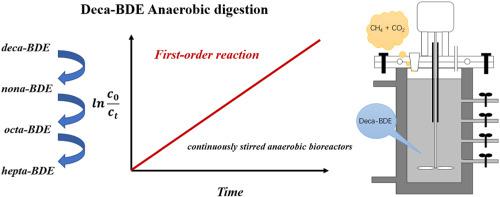Journal of Environmental Management ( IF 8.0 ) Pub Date : 2021-06-11 , DOI: 10.1016/j.jenvman.2021.113009 Chen Shi 1 , Yong Hu 2 , Takuro Kobayashi 2 , Nan Zhang 3 , Hidetoshi Kuramochi 2 , Zhenya Zhang 3 , Zhongfang Lei 3 , Kai-Qin Xu 4

|
Anaerobic digestion of decabromodiphenyl ether was carried out and compared in two continuously stirred anaerobic bioreactors for 210 days under thermophilic and mesophilic conditions. Results show that the degradation of decabromodiphenyl ether followed the first-order reaction kinetics, which exhibited a higher removal rate in the thermophilic reactor when compared to the mesophilic one, reaching its maximum of 1.1 μg·day−1. The anaerobic digestion of decabromodiphenyl ether was found to involve the replacement of bromines from polybrominated diphenyl ether by hydrogen atoms, gradually forming nona-, octa- and hepta-brominated diphenyl ether, respectively. Under the thermophilic condition, the reactors were dominated by Bacillus sp. and Methanosarcina sp. with high bioactivity and high concentrations of debromination microorganisms.
中文翻译:

高温和中温条件下长期运行的厌氧生物反应器中十溴二苯醚降解及其相关途径的比较
对十溴二苯醚进行厌氧消化,并在两个连续搅拌厌氧生物反应器中在高温和中温条件下进行 210 天的比较。结果表明,十溴二苯醚的降解遵循一级反应动力学,与中温反应器相比,在高温反应器中表现出更高的去除率,达到其最大值1.1 μg·day -1。发现十溴二苯醚的厌氧消化涉及用氢原子取代多溴二苯醚中的溴,逐渐分别形成九溴二苯醚、八溴二苯醚和七溴二苯醚。在高温条件下,反应器以芽孢杆菌为主。和甲烷八叠球菌sp. 具有高生物活性和高浓度的脱溴微生物。


















































 京公网安备 11010802027423号
京公网安备 11010802027423号